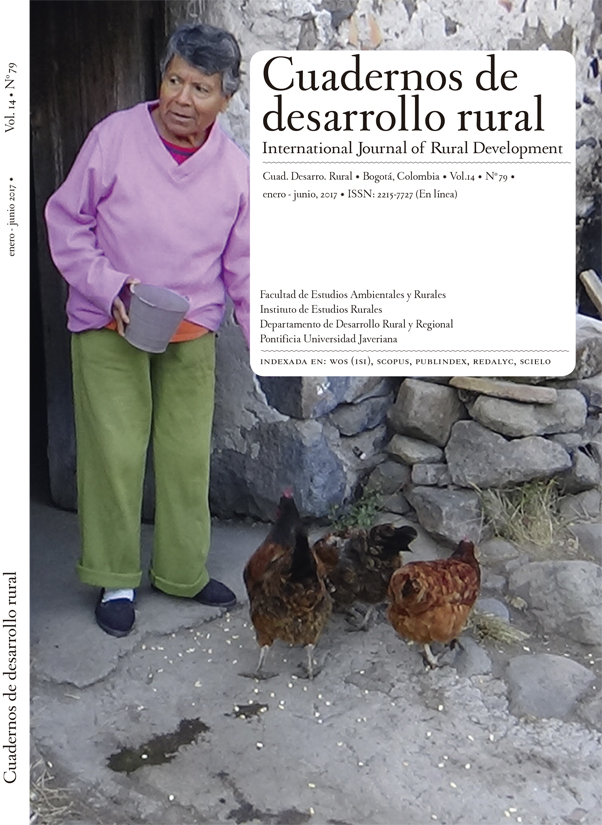Abstract
Producer-consumer linkages in a small rural market in Mexico are studied. Two short food supply chains were identified, which reduce producer-consumer distance and enable the exchange of information regarding egg origin and farming practices. This allowed the creation of food symbolism, increased consumers knowledge and trust on producer and their products. Producers increased knowledge regarding egg characteristics demanded and ways to satisfy such demand. It is concluded that small-scale egg producers are able to sale highly valued eggs by their tangible/intangible attributes, allowing closeness, confidence, food symbolism and exchange of information with consumers.
Aubry, C., & Kebir, L. (2013). Shortening food supply chains: A mean for maintaining agriculture close to urban areas? The case of the French metropolitan area of paris. Food Policy, 41, 85-93.
Ayim, M., & Akonor, P. (2014). Egg consumption: Patterns, preferences and perceptions among consumers in ACCRA metropolitan area. International Food Research Journal, 21(4), 1457-1463.
Brambila, J. (2011). Bioeconomía: Conceptos y fundamentos. México: COLPOS.
Caccia, S. (2012). Short circuits of production and consumption. In D. Danilo (Ed.), Inside a champion. An analysis of the Brazilian development model (pp. 172-181) Heinrich Boll Foundation.
Centeno, S. B., López, C. A., & Juárez, M. A. (2007). Producción avícola familiar en una comunidad del municipio de Ixtacamaxtitlán, puebla. Técnica Pecuaria México, 45(1), 41-60.
Espeitx, E. (1996). Los nuevos consumidores o las nuevas relaciones entre campo y ciudad a través de los productos de la tierra. Agricultura y Sociedad, (80), 83-116.
Fischler, C. (1988). Food, self and identity. Social Science Information, 27(2), 275-292.
Goodman, D., & Watts, M. (1997). Globalizing food. Agrarian questions and global restructuring. London: Routledge.
Hinrichs, C. (2000). Embeddedness and local food systems: Notes on two types of direct agricultural market. Journal of Rural Studies, 16, 295-303.
Holloway, L., Kneafsey, M., Venn, L., Cox, R., Dowler, E., & Tuomainen, H. (2007). Possible food economies: A methodological framework for exploring food production-consumption relationships. Sociologia Ruralis, 47(1), 1-19.
Jeréz, M., González, A., Herrera, J., Vásquez, M., Segura, J., & Villegas, Y. (2009). Mercadeo de huevos de gallinas criollas (Gallus gallus L.) en los valles centrales de Oaxaca, México. Etnobiología, 7, 86-93.
Kneen, B. (1995). From land to mouth. Understanding the food system (NC Press Limited ed.). Canada.
LEADER. (2017). Marketing local products: Short and long distribution channels. rural innovation archive. Retrieved from http://ec.europa.eu/agriculture/rur/leader2/rural-en/biblio/circuits/contents.htm
Marsden, T., Banks, J., & Bistrow, G. (2000). Food supply chain approaches: Exploring their role in rural development. Sociologia Ruralis, 40, 424-438.
Murdoch, J., & Miele, M. (1999). "Back to nature": Changing "worlds of production" in the food sector. Sociologia Ruralis, 39(4), 465-483.
Pearson, D., & Henryks, J. (2011). Local food: Understanding consumer motivations in innovative retail formats. British Food Journal, 113(7), 886-899.
Pratt, J. (2007). The local and the authentic. Critique of Anthropology, 27(3), 285-300.
Renting, H., Marsden, T., & Banks, J. (2003). Understanding alternative food networks: Exploring the role of short food supply chains in rural development. Environment and Planning A, 35, 393-411.
Santini, F., & Gomez, S. (2013). Short food supply chains and local food systems in the EU. A state of play of their socio-economic characteristics. España: JRC Scientific and Policy Reports.
Senbeta, E., Zekele, N., & Molla, Y. (2015). Attitudes and perceptions of consumers to chicken Eggs. Attributes in eastern Ethiopia. Journal of Animal Production Advances, 5(6), 705-710.
Smith, K., Lawrence, G., MacMahon, A., & Muller, J. (2016). The resilience of long and short food chains: A case study of flooding in Queensland, Australia. Agriculture and Human Values, 33, 45-60.
Verhaegen, I., & Van Huylenbroeck, G. (2001). Costs and benefits for farmers participating in innovative marketing channels for quality food products. Journal of Rural Studies, 17, 443-456.
Weatherell, C., Tregear, A., & Allinson, J. (2003). In search of the concerned consumer: UK public perceptions of food, farming and buying local. Journal of Rural Studies, 19, 233-244.
Zaragoza, L., Martínez, B., Rodríguez, V., Hernández, J., Rodríguez, G., & Perezgrovas, R. (2011). Avicultura familiar en comunidades indígenas de Chiapas, México. Actas Iberoamericanas de Conservación Animal, 1, 411-415.
Cuadernos de Desarrollo Ruralis registered under a Creative Commons Attribution 4.0 International Public License. Thus, this work may be reproduced, distributed, and publicly shared in digital format, as long as the names of the authors and Pontificia Universidad Javeriana are acknowledged. Others are allowed to quote, adapt, transform, auto-archive, republish, and create based on this material, for any purpose (even commercial ones), provided the authorship is duly acknowledged, a link to the original work is provided, and it is specified if changes have been made. Pontificia Universidad Javeriana does not hold the rights of published works and the authors are solely responsible for the contents of their works; they keep the moral, intellectual, privacy, and publicity rights.
Approving the intervention of the work (review, copy-editing, translation, layout) and the following outreach, are granted through an use license and not through an assignment of rights. This means the journal and Pontificia Universidad Javeriana cannot be held responsible for any ethical malpractice by the authors. As a consequence of the protection granted by the use license, the journal is not required to publish recantations or modify information already published, unless the errata stems from the editorial management process. Publishing contents in this journal does not generate royalties for contributors.



